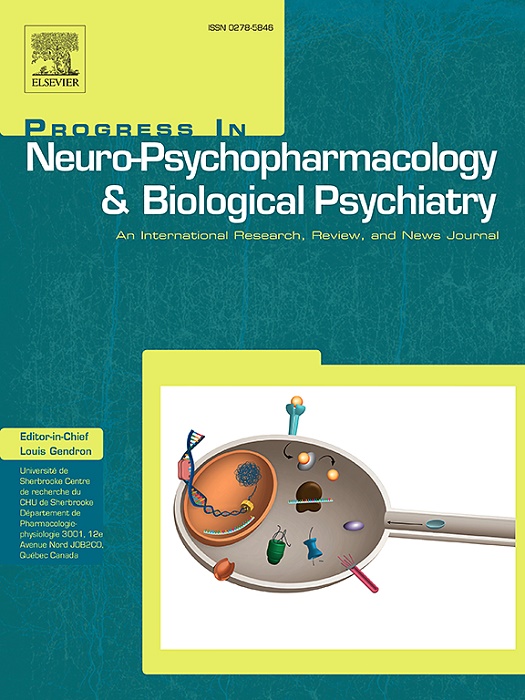Comparative proteome analysis of dried blood spots for high-risk group screening in children with autism spectrum disorder
IF 3.9
2区 医学
Q1 CLINICAL NEUROLOGY
Progress in Neuro-Psychopharmacology & Biological Psychiatry
Pub Date : 2025-09-13
DOI:10.1016/j.pnpbp.2025.111499
引用次数: 0
Abstract
Objective
Reliable biomarkers that assist in the diagnosis of autism spectrum disorder (ASD) are limited. This study aimed to identify proteins that can differentiate children with ASD from controls.
Methods
A total of 30 children with ASD and 30 control children participated in the study. Psychological tests and questionnaires to assess cognitive function, adaptive function, autism symptoms, and behavioral problems were administered. Dried blood spots collected from the participants were analyzed using the SWATH LC-MS platform. Core proteins were identified to build a classifying model to predict ASD and control group status.
Results
Among the 849 proteins quantified, 33 candidate proteins were identified by combining two different algorithms. Candidate proteins were involved in biological pathways related to the skin, muscle functioning, immune system, and cytoskeleton organization. Of the candidate proteins, we selected 7 core proteins that overlapped between different algorithms. The core proteins, PSME1, two isoforms of TPM1, two isoforms of TPM3, S100A6, and TBCA, were negatively correlated with the Childhood Autism Rating Scale, Aberrant Behavior Checklist, and Social Responsiveness Scale, and positively correlated with the Full-scale Intellectual Quotient. Furthermore, a logistic regression model with the core proteins predicted the ASD group with an area under the curve (AUC) of 0.956, sensitivity of 0.967, and specificity of 0.867.
Conclusion
We performed a proteomic analysis of dried blood spot (DBS) from ASD and control group children to explore candidate biomarkers. Our data supports the possibility of using proteins as potential biomarkers for ASD, although further verification is warranted in an independent cohort.
干血斑在自闭症谱系障碍儿童高危人群筛查中的比较蛋白质组分析。
目的:帮助诊断自闭症谱系障碍(ASD)的可靠生物标志物是有限的。这项研究的目的是鉴定能够区分自闭症儿童和对照组的蛋白质。方法:共30例ASD患儿和30例对照患儿参与研究。进行心理测试和问卷调查以评估认知功能、适应功能、自闭症症状和行为问题。使用SWATH LC-MS平台分析从参与者收集的干血斑。鉴定核心蛋白,建立预测ASD和对照组状态的分类模型。结果:在定量的849个蛋白中,结合两种不同的算法鉴定出33个候选蛋白。候选蛋白参与了与皮肤、肌肉功能、免疫系统和细胞骨架组织相关的生物途径。在候选蛋白中,我们选择了7个在不同算法之间重叠的核心蛋白。核心蛋白PSME1、TPM3、S100A6、TBCA 4种亚型与儿童自闭症评定量表、异常行为量表、社会反应量表呈负相关,与全量表智商呈正相关。基于核心蛋白的logistic回归模型预测ASD组的曲线下面积(AUC)为0.956,灵敏度为0.967,特异性为0.867。结论:我们对ASD和对照组儿童的干血斑(DBS)进行了蛋白质组学分析,以探索候选生物标志物。我们的数据支持使用蛋白质作为ASD的潜在生物标志物的可能性,尽管需要在一个独立的队列中进一步验证。
本文章由计算机程序翻译,如有差异,请以英文原文为准。
求助全文
约1分钟内获得全文
求助全文
来源期刊
CiteScore
12.00
自引率
1.80%
发文量
153
审稿时长
56 days
期刊介绍:
Progress in Neuro-Psychopharmacology & Biological Psychiatry is an international and multidisciplinary journal which aims to ensure the rapid publication of authoritative reviews and research papers dealing with experimental and clinical aspects of neuro-psychopharmacology and biological psychiatry. Issues of the journal are regularly devoted wholly in or in part to a topical subject.
Progress in Neuro-Psychopharmacology & Biological Psychiatry does not publish work on the actions of biological extracts unless the pharmacological active molecular substrate and/or specific receptor binding properties of the extract compounds are elucidated.

 求助内容:
求助内容: 应助结果提醒方式:
应助结果提醒方式:


